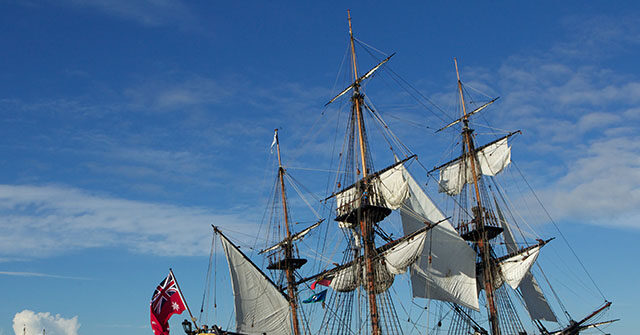Maritime experts appear to have finally determined the resting place of the HMS Endeavour, the legendary ship piloted by Captain James Cook, famed British navigator and explorer.
In what likely has solved a 250-year-old mystery, a report released earlier this month by the Australian National Maritime Museum (ANMM) pinpoints the wreck’s location just off the coast of Newport, Rhode Island.
CBS coverage summarized the connections between Cook, the ship, and Australia’s keen interest in the location:
Captain Cook famously sailed the Endeavour across the Pacific Ocean multiple times in the mid-1700s. He is remembered for his voyage to Tahiti, New Zealand and Australia, which he claimed for Britain, as well as Hawaii, where he ultimately met his fate in a dispute with indigenous residents. Cook’s exploration of the islands laid the foundation for British colonization in those areas.
That, according to the museum’s report, made it a key part of the continent’s history.
The ship was eventually used to transport troops and was sold to private owners who renamed it the Lord Sandwich and, in 1778, intentionally sank the ship, at that time no longer in good shape, to form an underwater barrier against French and American attacks during the American Revolution.
Its scant remains have long been thought to be resting off Rhode Island. But now experts are sure a state maritime archaeological site designated RI 2394 in the Newport Harbor is the final resting place, confirmed by decades of research and ten points of evidentiary criteria, according to the museum’s report.
The shipwreck is between 39 and 43 feet underwater.
Researchers, the New York Post reported, were able to confirm that it was indeed Cook’s lost ship by comparing the wreckage with the vessel’s historic plans, finding that the placement of certain timbers was a dead ringer for the locations of its main and fore masts in the outline.
“The size of all the timber scantlings are almost identical to Endeavour, and I’m talking within millimeters – not inches, but millimeters,” ANMM archaeologist Kieran Hosty told the Post. “The stem scarf is identical, absolutely identical.”
The stem scarf is the curved piece at the bow of the ship.
He added, “This stem scarf is also a very unique feature — we’ve gone through a whole bunch of 18th-century ship’s plans, and we can’t find anything else like it.”
Four iron canons were also present on the site, the report stated.
After HMS Endeavour, also known as the HM Bark Endeavour, sailed the world, it was sold in 1775, thus resulting in its renaming as the Lord Sandwich.
Contributor Lowell Cauffiel is the best-selling author of Below the Line and nine other crime novels and nonfiction titles. See lowellcauffiel.com for more.
Read the full article here


